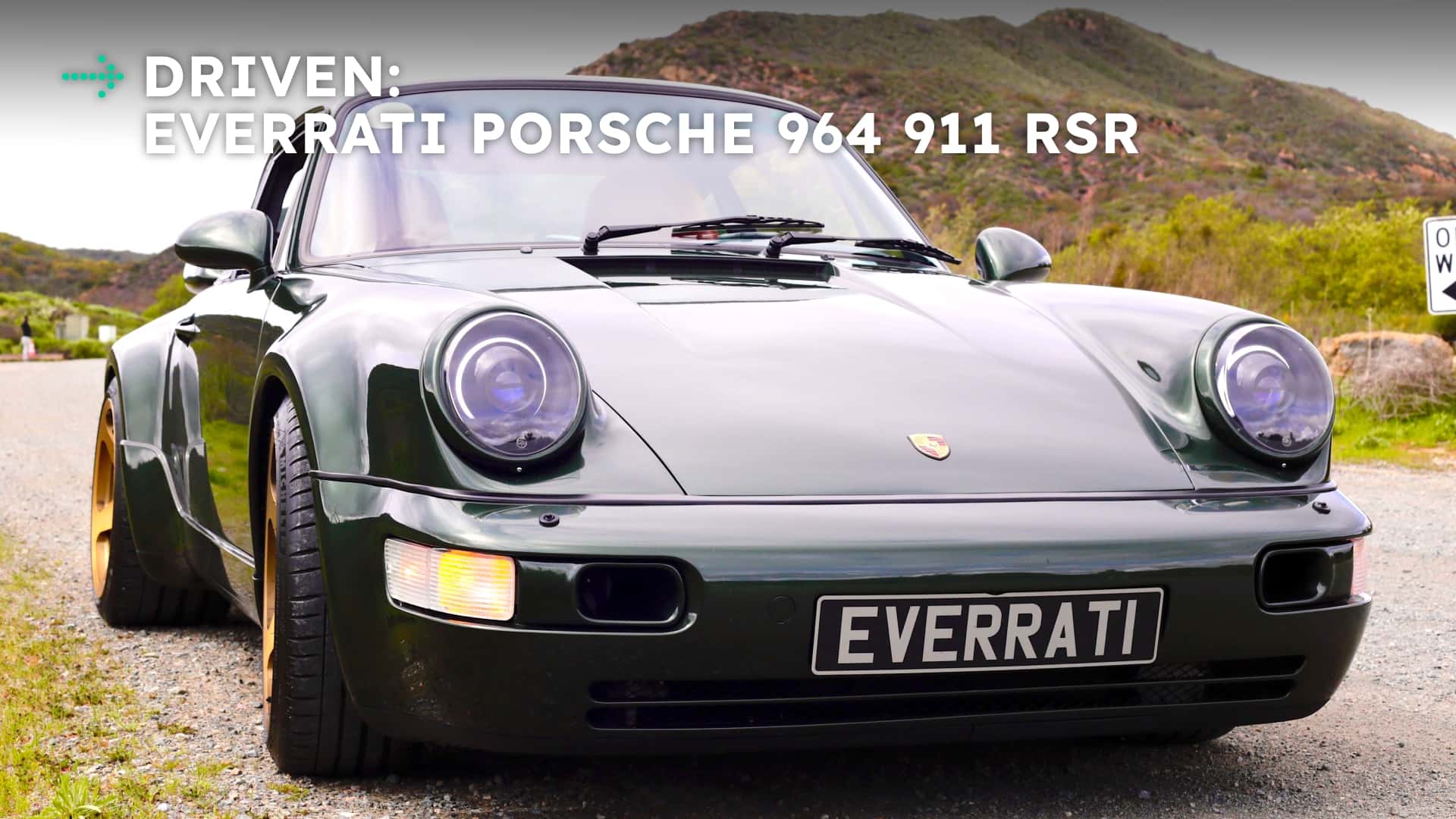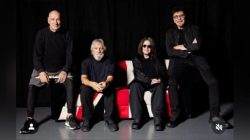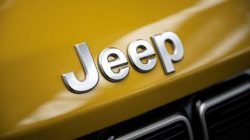Everrati’s Porsche 964 911 RSR conversion swaps its flat-six engine for batteries. Here’s why it works better than you may think.
Electrifying older iconic vehicles is nothing new. In fact, it’s become a fast-growing business over the past decade or so. When shops are on a mission to seamlessly bridge old and new technology, one question stands out as the ultimate litmus test of whether they’ve pulled it off: Is it sacrilege?
That’s because cars don’t gain icon status overnight. It takes a few generations for their roots to take hold, and once they do, it’s quite tough for someone to come along and update the formula.
Especially in the case of the
air-cooled Porsche 911
: between its gorgeous shape, motorsports heritage, unique rear-engine handling dynamics, and personality-filled engines, there’s a reason why it’s rooted especially deep in automotive enthusiasm. Swap out the flat-six motor value for batteries and an electric motor, and it certainly raises some eyebrows.
UK-based
Everrati Automotive Limited
has quickly risen to prominence for its finely crafted EV creations. But when it comes to EV-converting the 911, can they actually get it right? Put another way: have we achieved a level of EV technology that truly mimics—and even bolsters—authentic sports car driving dynamics?

Everrati Porsche 964 911 RSR
Recently, I had the opportunity to test drive one of the company’s fresh builds, styled in a manner that pays homage to the
964-generation (1988-1994) 911 RSR
. That’s the second-to-last air-cooled 911 generation, and is considered by Porsche faithfuls to be one of the most coveted ever produced.
On top of that, the RSR is one of Zuffenhausen’s most beloved motorsports-focused creations.
A lot is on the line here.
What Is Everrati?
Everrati has only been around for a few years, but in that time has achieved quite a lot. Its portfolio includes Series Land Rovers, Mercedes-Benz SL Pagodas, Ford GT40s, and several versions of Porsche 911, all built as commissions from discerning customers.

Everrati Porsche 964 911 RSR
Its personnel hail from all corners of the automotive industry, including such outfits as Rimac and other high-performance EV operations. Company officials told me they don’t see the operation as a conversion shop, but rather an EV technology company. In fact, a portion of its business is powertrain design for fellow low-production EV manufacturers.
“There’s a wide open space at the moment in EV,” Justin Lunny, Founder and CEO of Everrati recently shared with me in an interview. “If you’re going to buy a Rimac Nevera or Pininfarina Battista, you’re talking 2.5 to 3 million dollars. “The next price down is probably the high-end of the Porsche Taycan, realistically, and there’s nothing really in between. So there’s a big space there for companies to create true drivers’ EVs, and those are the kinds of companies that we work with.”
In fact, Everrati’s own builds are just that; be fun to rip around in, and in a manner that’s as true to the original as possible. This particular 964 I sampled, dubbed the Evergreen Commission, was built for Steve Rimmer, CEO of Dirtfish Rally School in Washington.
In doing so, the company’s expanding car enthusiasm, too. “Most of our clients are not necessarily traditional car people,” Lunny added. Instead, they have a deep love of design and technology, want something beautiful to drive around in, and don’t want to deal with the specialized upkeep or contributing to tailpipe emissions.
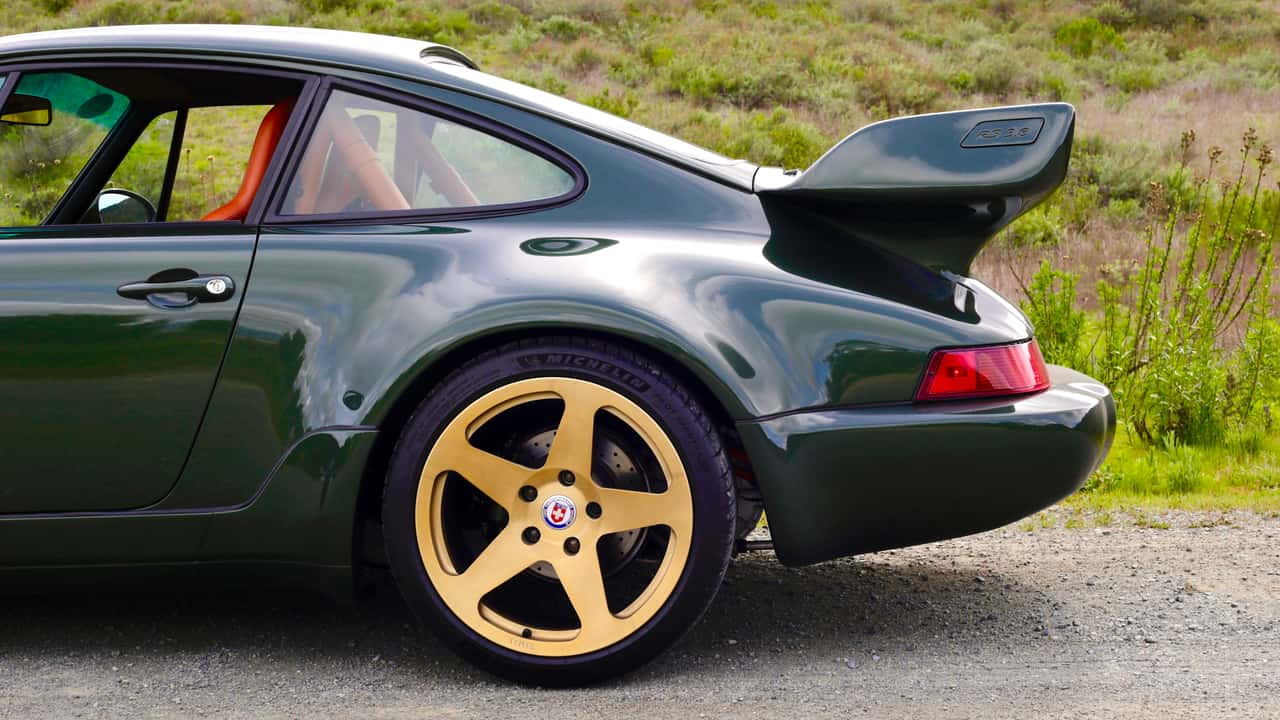
Everrati Porsche 964 911 RSR
Big takeaway: this shows that electrification can serve as a form of preservation by not only keeping older cars around longer, but also solidifying and expanding interest in them for the foreseeable future.
The Build
And what they craft together really is beautiful, too. All 964 builds start out as a donor car, which is typically a narrow-body Carrera model. If it possesses a Tiptronic automatic transmission—the bane of later air-cooled 911s’ existence—even better. Most collectors don’t bother with that gearbox and would rather get one with a stick-shift, so if you need an EV donor car, you may as well use this one.
Bodies start out at the Aria Group in Irvine, California, a supplier who, in the past, provided these services to Singer, one of the most prominent names in 911 reimagination. Their panels are swapped out for lighter carbon fare, the body is painted, aligned to perfection, and then sent to Everrati where the remaining extensive assembly happens.
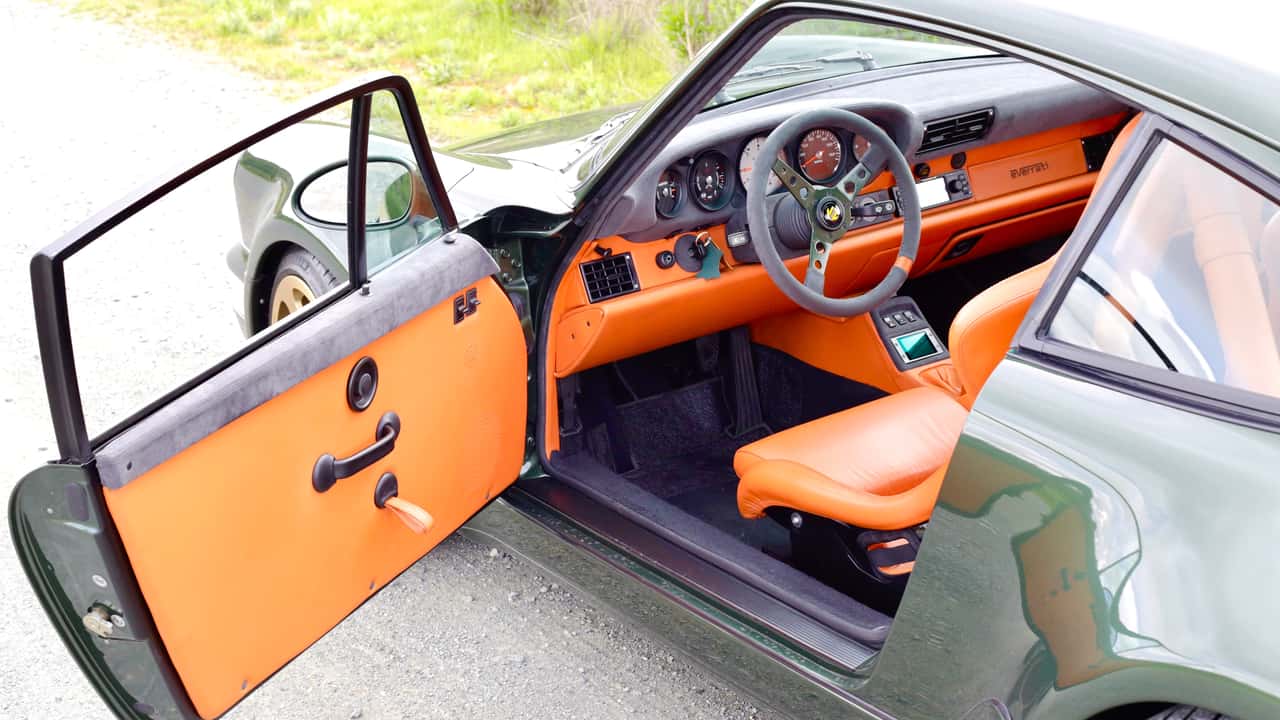
Everrati Porsche 964 911 RSR
The sum of its batteries are sourced from the Chinese company CALB and are 64 kWh units—70% of which is situated behind the passenger compartment, with the remaining 30% located where the gas tank once sat.
With this much charge, the brand says the 964 nets around 200 miles of range. For a performance-focused conversion job, that’s not even too bad. The rear wheels receive power from a refurbished Tesla unit by way of a limited-slip differential, then aftermarket wheels and tires, plus adaptive dampers by Tractive are bolted up. Finally, the vehicle is corner-balanced for the best possible handling.
The end product is a masterfully crafted, RSR-inspired work of art that fits right in with other high-end 911 reimagination fare. Pricing starts at around $500,000, and Everrati offers extensive customization in interior materials, colors, and more. The Evergreen commission was drop-dead gorgeous inside, featuring tan leather and handsome dark grey Alcantara throughout, and possessing an air of well-assembled quality.

Everrati Porsche 964 911 RSR
Everrati’s integration of added switchgear and touchscreens was very well executed, seamlessly blending old-school Porsche aesthetics with modern controls for drive modes, monitoring values, and more. Its charge port locations were a nice touch, too: a Level 2 plug (max. 6.6 kW) lives where the gas cap used to be, whereas a Level 3 (max. 70 kW) is situated under the hood. Then, the Porsche nerd in me appreciated the fact that the coolant reservoir’s cap is where the oil tank cap used to be.
Everrati Porsche 964 911 RSR: Driven
Technology’s reached the ability to electrify basically any chassis in a seamless, well-thought-out manner, like
Icon’s EV Bronco
that I recently drove—as long as the right engineering is involved, of course.
But capturing the essence of its original iteration’s driving experience, well, that takes a substantial amount of effort. Especially something like an old 911.

Everrati Porsche 964 911 RSR
I’m happy to report that what Everrati’s created drove blessedly well, and is as true to the original formula as one can get without internal combustion.
The authenticity revealed itself rather quickly on my brief test drive on Pacific Coast Highway in Laguna Beach, California. I felt the large mass of weight over the rear axle, especially as the chassis skimmed across the road’s bumps and undulations. The front end was light yet planted, its steering had excellent weight and communication, and steering response was textbook rear-engine Porsche. Everrati maintains the original 964 hydraulic steering rack in its builds to help preserve the 911 experience, and utilizes an electric pump to power it.
One might assume that when electrification is factored in, the curb weight goes through the roof. But that’s not the case here. Lunny shared that this electrified RSR tips the scales at just 3,220 pounds—for those who haven’t memorized all the specs of later air-cooled 911s (like myself, to a concerning degree), this is around 40 pounds lighter than the 964-generation Turbo model.
With a hearty push on the floor-mounted throttle, there was no mistaking the fact that electrons were shoving us along—the Everrati 911’s acceleration was certainly brisk with around 500 horsepower on tap. It’s a character-rich brisk; I could tell that engineers spent a lot of time getting the throttle mapping and motor tuning just right. The power curve was nicely progressive rather than something that stomps out all pounds-feet from the jump. One could say it was even an improvement over an original 964 Turbo, too, as there’s no delay in waiting for the turbos to light off. I can sense Porscheholics sharpening their pitchforks as I type this.

Everrati Porsche 964 911 RSR
As the Everrati 911 is rear-wheel drive, the brand was especially cognizant of how to deploy regenerative braking. Engineer too little into the formula, or none at all, and it negatively affects the driving experience. What sports car driving aficionado wants to simply coast in neutral every time they let off the throttle? However, engineer too much and it becomes a real hazard, as the rear wheels aren’t supposed to do that much work in shaving off speed. Once again, Everrati nailed it: letting off felt like coasting in fourth gear at 40 mph—just enough to possess some character but not negatively affect weight balance.
Rocketing out of corners onto a clear road ahead, I felt the rear end hunker down and shove us along without a hint of unexpected drama. I was also relieved to hear from Lunny that, if desired, it will gleefully oversteer with traction control turned down. Everrati’s facility in the UK is located on a former military airbase, after all.
Electricity As Preservation
Between its gorgeous, iconic looks, opulent interior, and above all, excellent driving experience, Everrati has come up with something quite special in this 964 Porsche 911 RSR commission.
Some enthusiasts will dig and appreciate it, some won’t. It’s a slippery slope, anyhow; some say the 911 should’ve never been blessed with coolant, and that 944s and 928s aren’t real Porsches. (Don’t get those people started on the Taycan.)
Can’t win ‘em all, but those who have an open mind won’t be disappointed. “Of course, you get the person that might not respect what you’re doing,” Lunny said. “But once people drive it, they actually really enjoy it, and I think it’s one of those things where if people are open-minded enough, they realize that we’re not trying to ruin these things, but rather preserve them for a future generation.”
In a broader sense, this applies to any attempt at an enthusiast EV, on the high-dollar low-production end and the mass-produced. We have the technology to give EVs character, replicate legacy models’ handling dynamics, make them genuinely fun to drive, and even widen their appeal across a broader market.
On the more mass-produced end of the spectrum: if Porsche itself has left no stone unturned in its upcoming EV 983-generation Porsche Boxster and Cayman’s driving experience, like Everrati has in its 911 commissions, then it’s a win for the future of sports car ownership.
Peter Nelson is a contributing writer for Motor1 and InsideEVs. His work has appeared on The Drive, Winding Road, Car Bibles, HotCars and more.
- Converting This Ford Model A To An EV Was Surprisingly Easy
- Why Tesla’s Large Drive Unit Is The V8 Engine Of EVs
- Icon’s Ford Bronco Proves Old Cars Can Have The Latest EV Tech
- The Original Mazda Miata Works Great As An EV
- Ford Mustang Fox-Body Goes Electric, Keeps The Manual Transmission
- Mercedes Taps Google For AI-Powered ‘Conversational Navigation’

